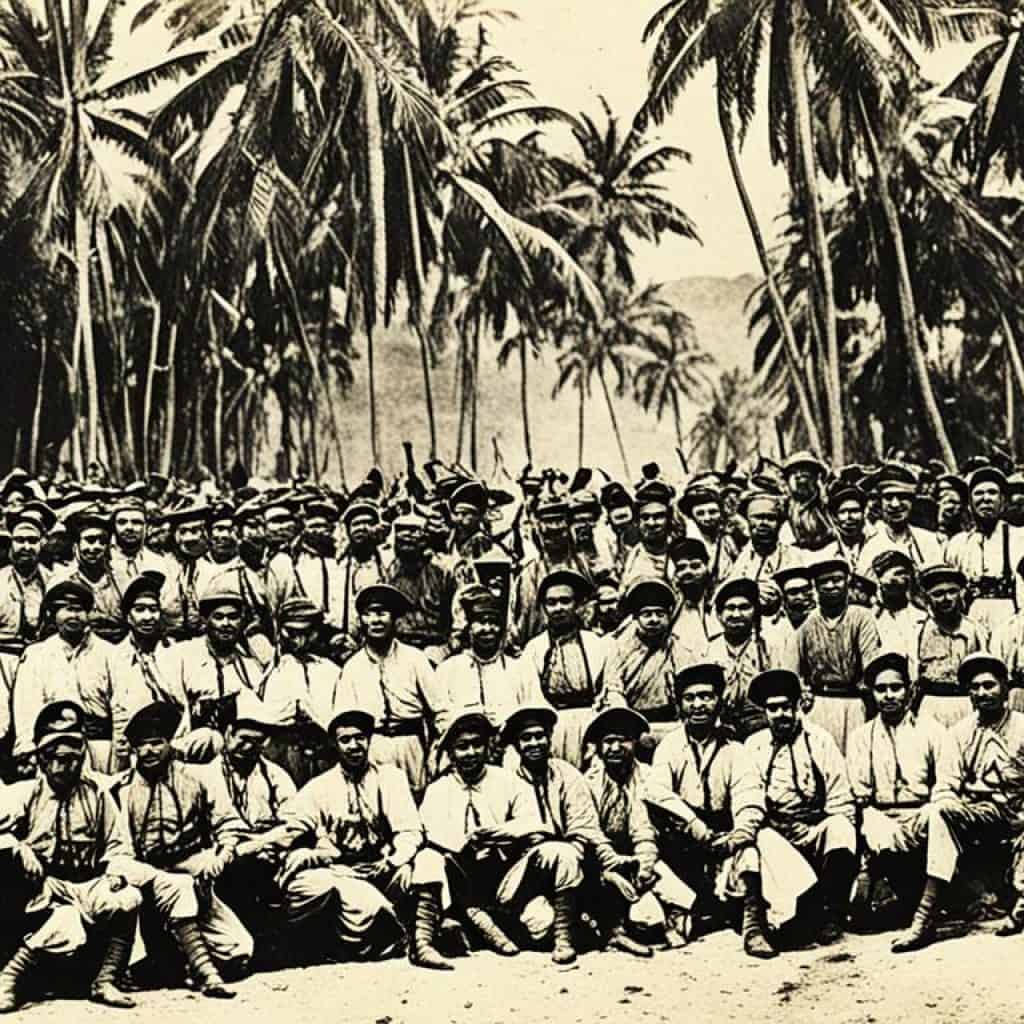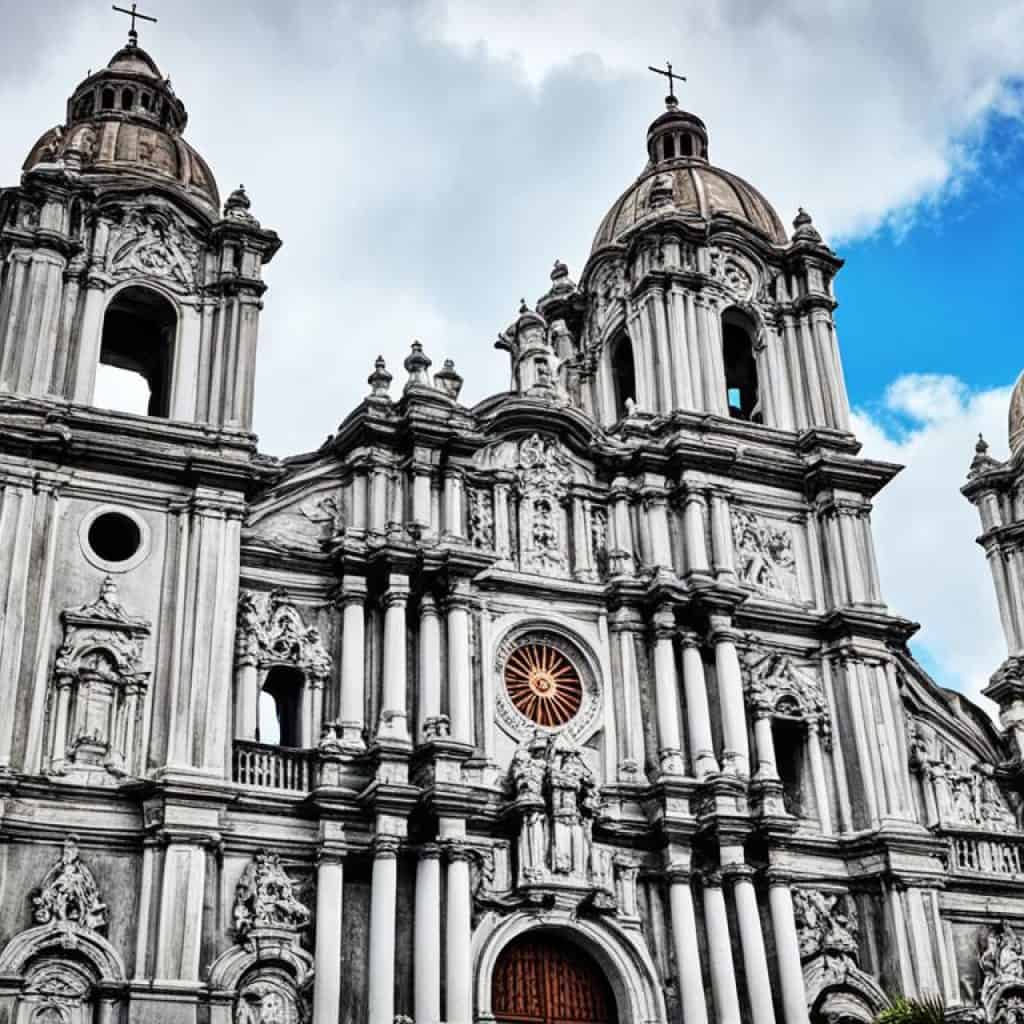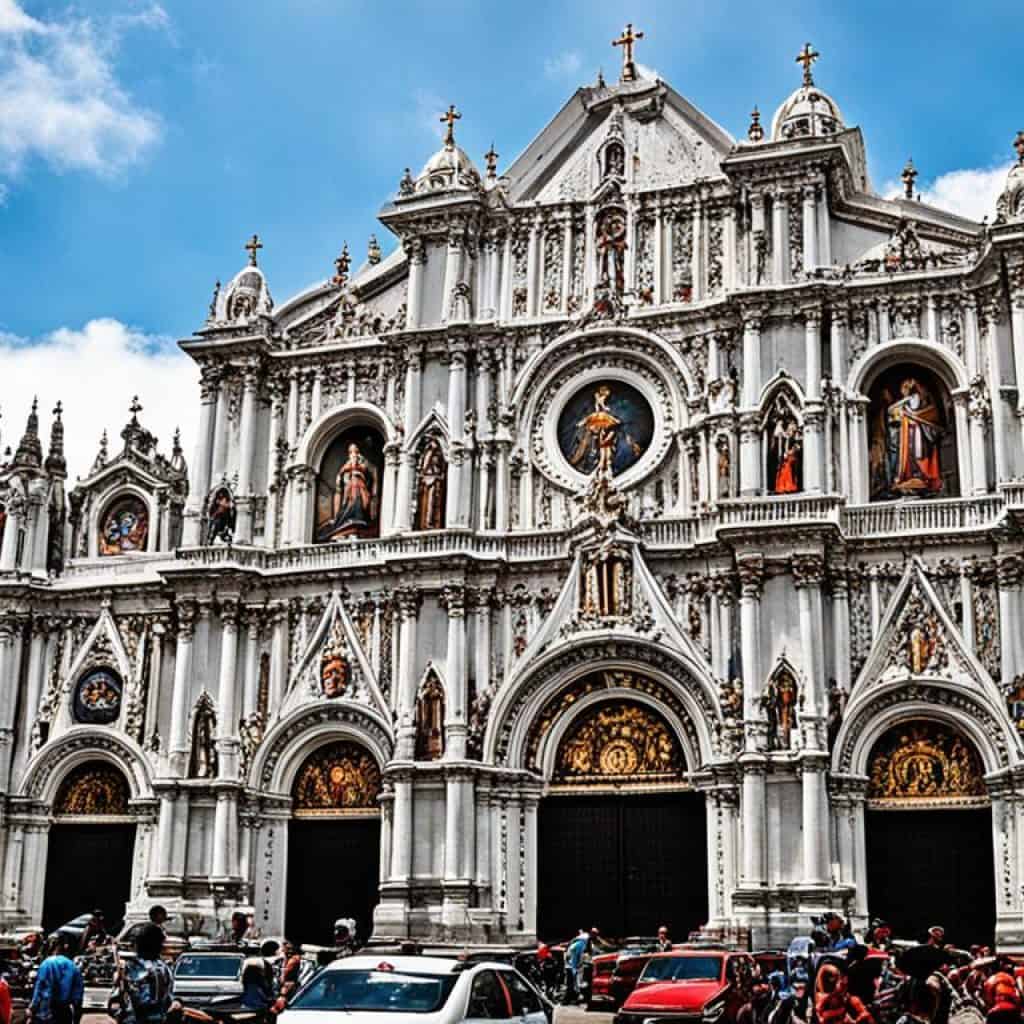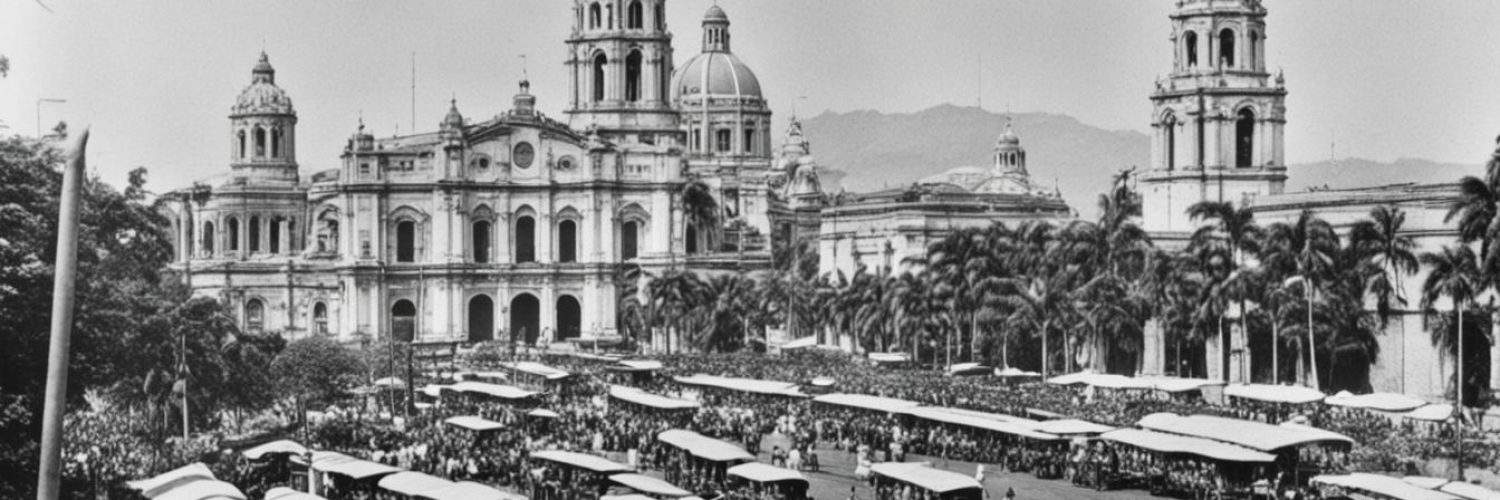When we think about the history of the Philippines, one significant era stands out: the Spanish period. Spanning over three centuries, this period of colonization and rule left an indelible mark on the archipelago. But how did the Spanish influence shape the Philippines? Did it bring prosperity or exploitation? And what remnants of this colonial legacy can still be seen today? Let’s dive into the fascinating world of the Spanish period in the Philippines and uncover the answers to these questions.
Key Takeaways:
- The Spanish colonization of the Philippines began in the 16th century, led by explorers like Ferdinand Magellan and Miguel Lopez de Legazpi.
- Spanish influence can be seen in various aspects of Filipino society, including language, religion, customs, and architecture.
- The Spanish period brought significant cultural achievements, such as the introduction of European art, music, and literature.
- The Spanish administration and governance shaped the hierarchical structure of government in the Philippines.
- The Spanish period ended with the defeat of Spain by the United States in the Spanish-American War, marking the beginning of the American colonial era.
Spanish Colonization and Conquest
The 16th century marked the beginning of Spanish colonization in the Philippines, as explorers such as Ferdinand Magellan and Miguel Lopez de Legazpi embarked on expeditions to the islands. These Spanish conquistadors encountered various indigenous groups and established settlements, gradually expanding Spanish control over the archipelago.
Spanish-Filipino relations during this period were characterized by a complex blend of conflict, cultural exchange, and intermarriage. While there were instances of warfare and resistance against the Spanish colonizers, there were also instances of cooperation and assimilation.
“The Spanish conquistadors played a pivotal role in shaping the history and development of the Philippines.”
The interactions between the Spanish and Filipino populations contributed to the formation of a unique cultural identity, blending indigenous traditions with Spanish influences. This fusion of cultures is evident in various aspects of Filipino society, including language, cuisine, religion, and traditions.
Spanish Colonization of the Philippines Timeline:
| Year | Event |
|---|---|
| 1521 | Ferdinand Magellan makes the first European contact with the Philippines |
| 1565 | Miguel Lopez de Legazpi establishes the first permanent Spanish settlement in Cebu |
| 1898 | Spanish rule ends with the defeat of Spain by the United States in the Spanish-American War |
Spanish Influence and Legacy
The Spanish period in the Philippines has had a profound impact on the country’s culture and heritage. Spanish influence can be seen in various aspects of Filipino society, from language and religion to customs and architecture.
Language: One of the most significant legacies of the Spanish period is the influence it had on the Filipino language. The Spanish language introduced many words and phrases that became an integral part of Filipino vocabulary. Today, Spanish loanwords can be found in everyday conversations, reflecting the enduring linguistic influence.
Religion: Another lasting impact of Spanish colonization is the introduction of Catholicism to the Philippines. Spanish missionaries played a crucial role in spreading the Catholic faith and establishing the Church in the country. Today, the Philippines boasts the third-largest Catholic population in the world, a testament to the enduring influence of Spanish religion.
Customs: Spanish traditions and customs also left their mark on Filipino society. From religious festivals and processions to traditional ceremonies and celebrations, Spanish customs merged with indigenous practices to create unique Filipino traditions. These customs continue to be passed down from generation to generation, keeping the Spanish influence alive.
Architecture: The Spanish period also left behind a wealth of architectural treasures in the Philippines. Spanish colonial architecture, characterized by its ornate facades and distinctive bell towers, can be seen in churches, buildings, and old structures throughout the country. These architectural gems stand as reminders of the Spanish legacy and serve as a visual testament to the historical interplay between cultures.
“The Spanish influence in the Philippines is visible in the language, religion, customs, and architecture, shaping the identity and cultural heritage of the nation.”
In summary, the Spanish influence and legacy in the Philippines are undeniable. From the Spanish language woven into everyday conversations to the enduring presence of Catholicism, the Spanish period has left an indelible mark on Filipino culture. This rich blend of influences continues to shape the cultural landscape of the Philippines, making it a unique and vibrant nation with a fascinating history.
Colonial Rule in the Philippines
During the Spanish colonial period, the Philippines was under direct rule from Spain. The Spanish established a centralized government with the governor-general as the highest authority. This governance structure allowed Spain to exert control over the islands and implement various policies and systems of governance.
One significant policy introduced during this time was the encomienda system. Under this system, Spanish colonizers were granted land and control over the indigenous population, whom they were responsible for protecting and converting to Christianity. In exchange, the encomenderos collected tribute and labor from the native population.
Additionally, the Spanish colonial government established towns, which served as centers of administration and control. These towns were governed by local officials appointed by the governor-general, who enforced Spanish laws and regulations.
The Spanish also implemented their legal and bureaucratic systems in the Philippines. Spanish laws were imposed, shaping the legal framework of the colony. The Spanish administration collected taxes from the local population to fund colonial activities and maintain order.

“The Spanish colonial period in the Philippines was characterized by centralized governance, the encomienda system, town establishments, and the imposition of Spanish laws and bureaucracy.”
The governance of the Philippines remained under Spanish rule until the end of the colonial period. This period of direct Spanish control ultimately shaped the political and administrative systems of the country, leaving a lasting impact on Philippine history and governance.
Spanish Missionaries in the Philippines
The Spanish missionaries played a significant role in the Spanish colonization of the Philippines. They were responsible for spreading the Catholic faith and converting the native population to Christianity. The missionaries established churches, schools, and religious orders throughout the islands. They also worked on translating religious texts into local languages, such as the Doctrina Christiana, a book that contained Christian teachings in Spanish and Tagalog.
The Spanish missionaries arrived in the Philippines with the goal of spreading the beliefs and practices of Catholicism. They saw the native population as a valuable demographic to convert, and through their efforts, Christianity quickly spread across the islands. Churches and religious institutions were established, serving as centers of worship and education. The Spanish missionaries played a crucial role in shaping the religious landscape of the Philippines, leaving a lasting legacy that can still be seen today.
| Missionary Orders | Founding Year |
|---|---|
| Order of Saint Augustine (Augustinians) | 1565 |
| Society of Jesus (Jesuits) | 1581 |
| Order of Friars Minor (Franciscans) | 1578 |
| Order of Preachers (Dominicans) | 1587 |
The Spanish missionaries not only focused on preaching and converting the population, but they also played a key role in the cultural and linguistic assimilation of the Filipino people. They worked on translating religious texts, allowing local communities to access Christian teachings in their native languages. The Doctrina Christiana, for example, provided the foundation for religious education in Spanish and Tagalog.
“The work of the Spanish missionaries in the Philippines was crucial in laying the foundation for the development of the Catholic Church and the integration of Christian beliefs into the fabric of Filipino society.” – Father Miguel López, Spanish missionary
The efforts of the Spanish missionaries in the Philippines were not without controversy, as they faced resistance from some indigenous groups who were reluctant to abandon their traditional beliefs. However, over time, the missionaries were able to establish a strong presence and heavily influence the religious and cultural landscape of the country.
Spanish Language in the Philippines
The Spanish language played a significant role in shaping the development of the Filipino language during the Spanish colonial period. It became the language of the government, education, and the elite, leaving a lasting influence on the linguistic landscape of the Philippines.
Drawing from Spanish vocabulary and phrases, Filipino languages incorporated numerous loanwords that continue to be used today. These linguistic borrowings have enriched the Filipino language, adding a layer of cultural heritage and reflecting the historical ties between Spain and the Philippines.
Although Spanish is no longer widely spoken in the Philippines, its impact can still be observed in various aspects of Filipino culture. From formal titles and family names to food and religious celebrations, Spanish influence is deeply ingrained, demonstrating the enduring legacy of the Spanish language.
The image above highlights the continuing influence of the Spanish language in the Philippines. It serves as a reminder of the historical connection between Spain and the Filipino people, showcasing the rich cultural tapestry that has evolved over centuries.
Spanish Cultural Achievements in the Philippines
The Spanish period in the Philippines brought with it a rich tapestry of cultural achievements that continue to shape the country to this day. Through their exploration and colonization efforts, the Spanish introduced European art, music, and literature to the Filipino people, leaving an indelible mark on their artistic and cultural traditions.
“The arts enable us to express our deepest emotions and connect with our cultural heritage.” – Filipino Artist
One of the most significant contributions of the Spanish to the Filipino cultural landscape is the influence of Spanish architecture. The grand colonial churches and buildings that dot the Philippines are not only architectural marvels but also enduring symbols of the country’s history and heritage. These structures stand proudly amidst bustling cityscapes and rustic towns, showcasing the fusion of Spanish and indigenous design elements.

Spanish literature and poetry flourished during this period, producing notable Filipino writers who captured the essence of the Filipino experience. Jose Rizal, a revered Filipino author and national hero, used his writings to voice the sentiments of the Filipino people in the face of colonial oppression. His works, such as Noli Me Tangere and El Filibusterismo, challenged the status quo and inspired a spirit of nationalism.
“Literature has the power to ignite change and ignite the spirit of a nation.” – Filipino Writer
The Spanish period also heralded a cultural exchange between the Spanish and the indigenous Filipinos. Local artistic expressions and traditions influenced by Spanish aesthetics emerged, resulting in unique art forms, dances, and music that blend indigenous rhythms and Spanish melodies. This vibrant fusion of cultural influences continues to thrive in contemporary Filipino arts and performances.
Influences of Spanish Cultural Achievements:
- Incorporation of European art, music, and literature in Filipino culture
- Integration of Spanish architectural styles in the construction of colonial churches and buildings
- Emergence of notable Filipino writers and poets
- Fusion of Spanish and indigenous artistic expressions in Filipino arts and performances
Spanish cultural achievements have become an integral part of Filipino society, showcasing the rich tapestry of the country’s history and heritage. The interplay between Spanish influences and indigenous Filipino traditions has shaped a unique cultural identity that continues to evolve and flourish.
Spanish Economy and Trade in the Philippines
The Spanish colonization of the Philippines not only brought about significant changes in governance and culture but also had a profound impact on the economy of the archipelago. The Spanish introduced trade routes that connected the Philippines with other Spanish colonies, most notably Mexico. The Manila galleon trade, a maritime route that transported goods between Manila and Acapulco, became a vital source of wealth and trade for Spain.
During the Manila galleon trade, valuable commodities such as silver, gold, silk, porcelain, spices, and luxury goods were exchanged between Asia and the Americas. This trade route played a pivotal role in establishing the Philippines as a hub for global exchange and contributed to the growth of the Spanish economy. The flow of goods and wealth enriched both Spanish merchants and the colonial administration.
The Spanish also introduced cash crops and promoted agriculture and mining in the Philippines. The cultivation of valuable crops such as tobacco and indigo became lucrative industries and contributed to the growth of the Philippine economy. The Spanish actively encouraged agricultural development, establishing plantations and introducing advanced farming techniques. In addition, mining operations were established to extract precious metals such as gold and silver.
The Spanish administration implemented policies to regulate trade and ensure its profitability. The Casa de Contratación, a Spanish institution responsible for regulating trade with the colonies, closely monitored the flow of goods and imposed tariffs and customs duties. The Spanish also established monopolies on certain goods, ensuring that profits from trade were channeled back to the empire.
“The Spanish colonization in the Philippines opened up new economic opportunities through trade routes and the cultivation of cash crops, contributing to the growth of the Spanish economy.”
The economic impact of Spanish colonization in the Philippines was substantial. It transformed the archipelago into a hub of international trade and introduced industries that fueled economic growth. However, it’s important to note that the benefits of this economic development were primarily accrued by the Spanish empire, with the local Filipino population often facing exploitation and economic inequality.
| Impact of Spanish Economy and Trade in the Philippines | Description |
|---|---|
| Manila Galleon Trade | The Manila galleon trade created a vital transoceanic link between the Philippines and Acapulco, generating significant wealth and trade opportunities for Spain. |
| Cash Crop Cultivation | Introducing cash crops like tobacco and indigo stimulated agricultural production and contributed to the growth of the Philippine economy. |
| Mining Industry | The Spanish promoted mining operations to extract precious metals, such as gold and silver, further diversifying the economy. |
| Regulation and Monopolies | The Spanish implemented policies and regulations to control and profit from trade, imposing tariffs, customs duties, and establishing monopolies on certain goods. |
The Spanish economy and trade in the Philippines played a crucial role in shaping the colonial period’s dynamics and impacting the development of the archipelago.
Spanish Administration and Governance in the Philippines
The Spanish colonial government in the Philippines operated under a hierarchical structure, with the governor-general serving as the highest authority. The governor-general held the power to appoint civil and military officials who governed different regions of the islands. These officials were responsible for implementing laws, regulations, tax collection, and maintaining order within their jurisdictions. The goal of Spanish governance in the Philippines was to maintain control and secure the loyalty of the native population.
To better understand the structure of Spanish administration in the Philippines, let’s take a look at the following table:
| Position | Description |
|---|---|
| Governor-General | The highest-ranking official appointed by the Spanish Crown. Responsible for overseeing the administration of the entire archipelago. |
| Audiencia | The supreme court and advisory body to the governor-general. Comprised of judges who assisted in the governance and legal matters of the colony. |
| Vice Royalties | Additional regional authorities appointed by the governor-general to assist in governing specific areas. |
| Captains and Corregidors | Local government officials who oversaw municipalities and provinces. They were responsible for enforcing laws, collecting taxes, and maintaining order within their jurisdictions. |
| Religious Orders | The Spanish Catholic Church had a prominent role in governance, with religious orders establishing their own missions and territories. |
The structure of Spanish administration in the Philippines facilitated centralized control and efficient governance. The governor-general, supported by the Audiencia and vice royalties, exercised authority over the entire colony. Captains and corregidors ensured the implementation of policies at the municipal and provincial levels. Additionally, the Spanish Catholic Church, represented by various religious orders, played a significant role in both religious and administrative activities.
It is important to note that Spanish governance in the Philippines had both positive and negative impacts. While it brought stability, organized governance, and established institutions, it also exploited local resources and suppressed the aspirations of the native population for self-governance.
Spanish Religion and Catholicism in the Philippines
The Spanish period in the Philippines had a profound impact on the religious landscape of the country. The arrival of Spanish missionaries brought the Catholic faith to the islands, paving the way for Catholicism to become the dominant religion in the Philippines.
The Spanish missionaries played a crucial role in spreading the Catholic faith and establishing the Church in the Philippines. They built churches, established religious orders, and worked tirelessly to convert the native population to Catholicism. The Catholic Church became a central institution, exercising significant influence over the daily lives and beliefs of the Filipino people.
“The Catholic faith is a cornerstone of Filipino culture and identity. It is deeply ingrained in our traditions, festivals, and values. The Spanish period laid the foundation for the enduring influence of Catholicism in the Philippines.”
The Spanish authorities actively promoted Catholic religious festivals and traditions, many of which continue to be celebrated to this day. Festivals such as the Feast of the Santo Niño, the Semana Santa, and the Simbang Gabi are integral parts of Filipino religious and cultural life, reflecting the rich Catholic heritage shaped by centuries of Spanish influence.
In addition to its religious significance, Catholicism also played a crucial role in the social and political fabric of the Philippines during the Spanish period. The Catholic Church served as a unifying force, providing educational and social services to the Filipino community. It also played a part in shaping the Filipino identity, fostering a sense of unity among the diverse population of the islands.
Despite the changes brought by modernization and globalization, the influence of Catholicism remains strong in the Philippines. The Catholic Church continues to play a significant role, voicing social concerns, advocating for social justice, and providing moral guidance to its followers.

Spanish Resistance and Uprisings in the Philippines
The Spanish colonial period in the Philippines was characterized by a spirit of resistance and numerous uprisings against Spanish rule. The Filipino people, including various indigenous groups and local leaders, courageously fought against the Spanish conquest and colonization of their land.
One of the notable uprisings was the Tondo Conspiracy, a revolt by Filipino nobles in the late 1580s that aimed to overthrow Spanish colonizers. Although the uprising was ultimately unsuccessful, it demonstrated the determination of the Filipino people to resist foreign domination and fight for their freedom.
In 1521, Lapu-Lapu, the chieftain of Mactan, led a brave counterattack against the Portuguese explorer Ferdinand Magellan during the Battle of Mactan. This battle is regarded as one of the earliest acts of resistance against foreign invaders in Philippine history. Lapu-Lapu’s victory showcases the indomitable spirit of the Filipino people and their commitment to defending their homeland.
“This country is so fine and the same… I swear that there is no richer island in the world.” – Ferdinand Magellan
Another prominent uprising was the Philippine Revolution, spearheaded by Andres Bonifacio and the secret society Katipunan. The revolution, which broke out in 1896, aimed to achieve independence from Spanish rule. Despite facing significant challenges, the Philippine Revolution marked a crucial turning point in the country’s struggle for self-determination.
These resistance movements and uprisings played a crucial role in shaping Philippine history and inspiring future generations to continue the fight against colonial oppression. Their bravery and resilience contribute to the rich cultural heritage and national identity of the Filipino people.
Notable Uprisings and Revolts
| Uprising | Year | Leaders |
|---|---|---|
| Tondo Conspiracy | Late 1580s | Filipino nobles |
| Battle of Mactan | 1521 | Lapu-Lapu |
| Philippine Revolution | 1896 | Andres Bonifacio |
The table above highlights some of the significant uprisings and revolts that took place during the Spanish colonial period in the Philippines. These acts of resistance demonstrate the unwavering spirit of the Filipino people in their pursuit of freedom and sovereignty.
The End of Spanish Rule in the Philippines
After centuries of Spanish colonization, the rule of Spain in the Philippines finally came to an end with the conclusion of the Spanish-American War. The defeat of Spain by the United States in 1898 marked a significant turning point in Philippine history, setting the stage for a new era of foreign control.
The Spanish-American War resulted in the Treaty of Paris, which transferred control of the Philippines from Spain to the United States. This transition signaled the beginning of the American colonial era in the Philippines. The American government now held the reins of power over the archipelago, bringing about far-reaching changes and shaping the course of Philippine history.
The end of Spanish rule in the Philippines had profound implications for the country’s political, social, and cultural landscape. It marked the start of a new chapter characterized by American influence and control. The transition from Spanish to American rule presented both opportunities and challenges for the Filipino people, paving the way for future struggles for independence.
Key Points:
- The defeat of Spain in the Spanish-American War brought an end to Spanish rule in the Philippines.
- The Treaty of Paris transferred control of the Philippines from Spain to the United States in 1898.
- This marked the beginning of the American colonial era in the Philippines.
- The transition from Spanish to American rule set the stage for future struggles for independence.
As the Philippines transitioned from Spanish to American rule, the Filipino people would navigate the complexities of a new colonial power, eventually shaping their own destiny and reclaiming their independence.
Conclusion
The Spanish period in the Philippines has had a profound impact on the country, shaping its culture, language, and history. Spanish colonization and governance, though met with resistance and uprisings, brought significant changes that are still evident today.
The Catholic faith introduced by Spanish missionaries became deeply ingrained in Filipino society, with Catholicism remaining the dominant religion. The Spanish language, once widely spoken, continues to influence the Filipino language, with many Spanish loanwords and phrases integrated into daily conversation.
The legacy of Spanish rule is also evident in Philippine architecture, with colonial churches and buildings serving as enduring landmarks. Spanish influence extended to various aspects of Filipino life, including customs, traditions, and cuisine.
The Spanish period, with its complex interplay between Spanish colonizers and the indigenous population, laid the foundation for the modern Philippines. It set the stage for future struggles for independence and shaped the aspirations of the Filipino people.


















Add comment